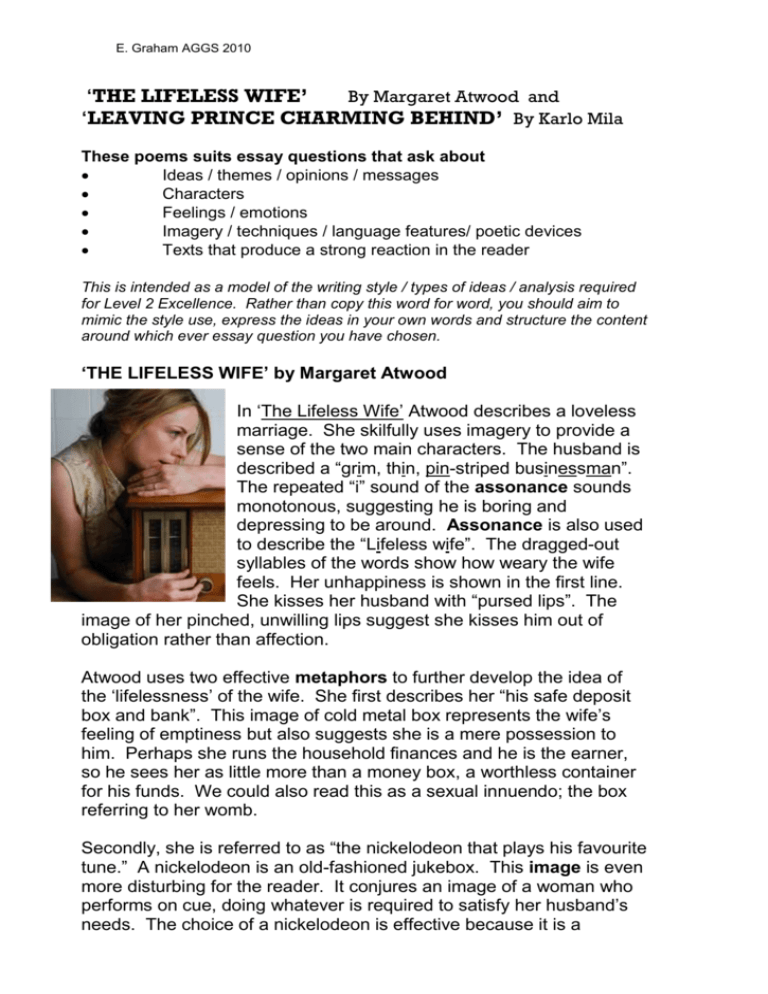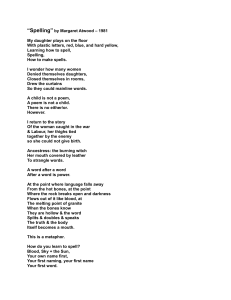'The Lifeless Wife' by Margaret Atwood
advertisement

E. Graham AGGS 2010 ‘THE LIFELESS WIFE’ By Margaret Atwood and ‘LEAVING PRINCE CHARMING BEHIND’ By Karlo Mila These poems suits essay questions that ask about Ideas / themes / opinions / messages Characters Feelings / emotions Imagery / techniques / language features/ poetic devices Texts that produce a strong reaction in the reader This is intended as a model of the writing style / types of ideas / analysis required for Level 2 Excellence. Rather than copy this word for word, you should aim to mimic the style use, express the ideas in your own words and structure the content around which ever essay question you have chosen. ‘THE LIFELESS WIFE’ by Margaret Atwood In ‘The Lifeless Wife’ Atwood describes a loveless marriage. She skilfully uses imagery to provide a sense of the two main characters. The husband is described a “grim, thin, pin-striped businessman”. The repeated “i” sound of the assonance sounds monotonous, suggesting he is boring and depressing to be around. Assonance is also used to describe the “Lifeless wife”. The dragged-out syllables of the words show how weary the wife feels. Her unhappiness is shown in the first line. She kisses her husband with “pursed lips”. The image of her pinched, unwilling lips suggest she kisses him out of obligation rather than affection. Atwood uses two effective metaphors to further develop the idea of the ‘lifelessness’ of the wife. She first describes her “his safe deposit box and bank”. This image of cold metal box represents the wife’s feeling of emptiness but also suggests she is a mere possession to him. Perhaps she runs the household finances and he is the earner, so he sees her as little more than a money box, a worthless container for his funds. We could also read this as a sexual innuendo; the box referring to her womb. Secondly, she is referred to as “the nickelodeon that plays his favourite tune.” A nickelodeon is an old-fashioned jukebox. This image is even more disturbing for the reader. It conjures an image of a woman who performs on cue, doing whatever is required to satisfy her husband’s needs. The choice of a nickelodeon is effective because it is a E. Graham AGGS 2010 plaything that only works when a button is pushed and a nickel put in. This suggests the wife has no power: she is completely submissive to her husband and seems to exist for his pleasure only. The writer’s tone uses litotes (deliberate understatement) when she says, “she was just an ordinary woman.” This implies she did nothing wrong to deserve such treatment, was not overly stupid or weak or passive – rather she was just a victim of a domineering man and a patriarchal society. Secondly, and more devastatingly, Atwood seems to be suggesting this situation is common or ‘ordinary’. This poem is not just criticising this relationship, it is criticising the way society allows men to dominate women and the fact that this is an ‘ordinary’ situation. The last part of the poem is the most devastating. Atwood says “all he had to do to make her fully his / in pure domestic bliss / was just break through her backbone, / empty out her head / stuff her heart with money and bury her in bed.” The reference to ‘pure domestic bliss’ is ironic, as this marriage seems more like hell than bliss. However it also refers to the cliché term used to describe a happily married couple, which is another way Atwood makes the reader question conventional gender relations. The words “break”, “empty”, “stuff” and “bury” have violent connotations. They are verbs more associated with theft or murder than love and marriage. The wife ‘breaks her back’ doing housework, has had her head ‘emptied’ of her own ideas and dreams, has only room in her heart for her husband’s paycheck, and feels like a corpse in the marriage bed. The strong rhyme of “head” and “bed” as well as the alliteration of “break…backbone … bury …bed” creates a forceful rhythm which reinforces the violent images. As a result the reader is left feeling pity for the woman and anger about the situation. Thus Atwood achieves her aim of increasing of our understanding the inequality of men’s and women’s roles in conventional marriages. Context: Author’s purpose & background Margaret Atwood has written a number of books, such as The Handmaid’s Tale, that have feminist themes and attack patriarchal social structures (male-dominated rule in society). This includes the idea that when men married, their wives became their ‘property’. Until the advent of Feminism in the1970s, most were expected to stay home, raise children and do housework while their husbands went to work. Most took their husband’s names and received mail addressed to ‘Mr & Mrs John Smith’. Feminists began to question the way women did not have equal rights and equal opportunities in work and in society. They encouraged women not to change their names and E. Graham AGGS 2010 campaigned for women to have the right to choose – whether to have children or not, stay at home or work outside the home. In the 70s a disorder called “suburban neurosis” was defined. It was a “form of neurosis said to occur especially among suburban housewives which is associated with feelings of boredom, loneliness and lack of personal fulfillment." The woman in this poem seems to suffer from this disorder. As a character she stands for all the women who feel marginalised in playing the role of ‘wife’. ‘LEAVING PRINCE CHARMING BEHIND’ Karlo Mila This poem describes a failed relationship, where the speaker decides to leave her lover due to her feelings of dissatisfaction about the role she was expected to play. Like Atwood’s poem, Mila offers a critique of traditional gender roles in relationships – in particular the idea that women ought to adopt a passive, submissive role and men hold the dominant, active one. Early on in the poem, Mila sets up a contrast between the expectations that her relationship would end ‘happily ever after’ and the reality. She conveys by using a indenting a space in the line, “For a while I thought we were living the fairy tale, but sadly I realised that this was the myth.” When the poem is read this creates a pause which suggests hesitation or a ‘disruption’ in proceedings. Visually, the large space indicates the gap between her hopes for a ‘fairytale’ (perfect, idyllic) relationship and the reality that this was a “myth” (a fiction, untrue). The words ‘myth’ and ‘fairytale’ are synonyms which add to the word play in this line. One of the most distinctive features of this poem is its use of fairy tale allusions, as suggested by the title. However, Mila goes to pains to show that the persona’s former lover was no ‘Prince Charming’. He is reduced to sarcastic descriptions such as ‘my poor dark prince’ and told, ‘the glass slipper didn’t fit”, “your kiss could not wake me up to your way of thinking.” Mila here is alluding to the stories of Cinderella and Snow White, where the handsome prince comes to rescue the heroine from her miserable life, bestows upon her a kiss, and they marry only to live happily ever after. Girls in Western society, influenced by movies and books, often expect to meet a perfect man – a “Prince Charming” who will sweep them off their feet, propose and lead them into a blissful marriage. Mila’s poem deliberately subverts these myths. Her comment “your kiss could not wake me up to your E. Graham AGGS 2010 way of thinking” suggests that the persona was not willing to abandon her own ideas, hopes and dreams to fit in with her partner. The poet also uses a fairy tale allusion when describing the persona’s role in the relationship. She writes, “I am Rapunzel with her dreadlocks shorn / trying to pull down the tower with broken nails, cursing your name.” Once again, Mila’s image reverses the stereotype of a fairytale princess with long blonde hair and a sweet, submissive nature who waits patiently for her prince to come. In contrast, Mila’s heroine had deadlocks – a sign of a gutsy personality and a strong identity, and rather than sit passively in a tower, she is actively trying to destroy it in an angry rage. In this scenario, her lover is described somewhat bitterly as “the architect of my isolation” – as if he designed the means of her loneliness and lack of fulfilment in the relationship. Her resentment of her ex-lover’s attempts to control her are also expressed in the line, “I rejected the role of princess in your production” which suggests the man acted as if he were a director in charge of a play rather than an equal partner in their relationship. Mila continues her reversal of stereotypes right up until the last stanza of the poem, where she declares, “I transformed myself into a beautiful dragon / you felt honour-bound to slay.” The reader gets a sense of the persona’s feeling of defiance and her absolute refusal to play the weakling princess in this story. She turns the typical fairy tale upside down by transforming not from servant girl to princess, but from princess to dragon. Dragons are usually the ‘monster’ in fairytales that threaten the innocent and helpless princess, before she is rescued by the prince. However, the use of the word “beautiful” suggests she wants the reader to see the dragon in a positive light - as a powerful, gorgeous being that can take care of itself. We are encouraged to disapprove once more of the lover, who in his insecurity felt “honour bound” to slay the dragon – as if an assertive woman was ‘monstrous’ and a threat to his power as a male. Author’s purpose Mila once said in regards to her poetry that ‘the personal is political’. This poem exemplifies Mila’s position. The well-known Feminist quote refers to the idea that personal experiences contain political truths. A relationship break-up can show us cultural and social attitudes towards women, men, love and romance. Here, while the man is more strongly criticised for his condescending attitude towards the woman, there is also an implicit critique of herself and other men and women who E. Graham AGGS 2010 continue to believe in “fairytales” – myths about romance and relationships. These can create unrealistic expectations, set rigid and outdated roles for both sexes, and often end in heartbreak.







